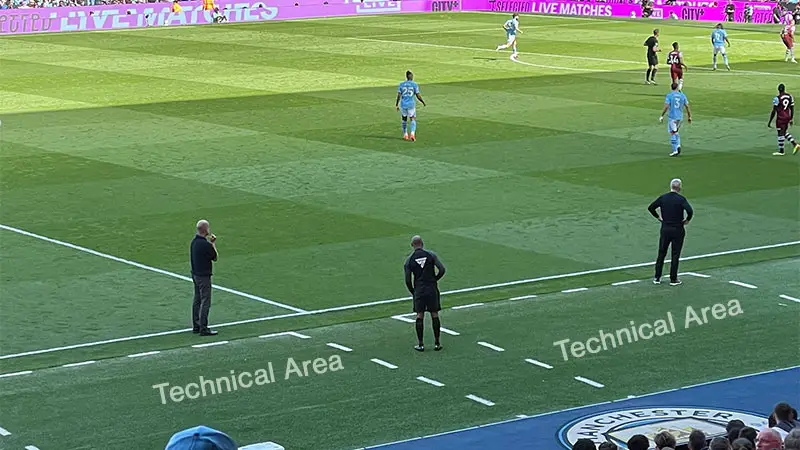In the high-stakes world of soccer, every detail matters, including the often-overlooked technical area. This designated space on the sidelines plays a crucial role in the game’s dynamics, serving as the nerve center for coaches and team staff.
It’s where strategies evolve, decisions are made on the fly, and where the emotional pulse of the game can be felt most intensely.
Understanding the technical area’s significance can offer deeper insights into how teams operate and succeed. From tactical adjustments to player substitutions, the activities within this zone can impact the outcome of matches.
Dive into the intricacies of the soccer technical area and discover why it’s much more than just a spot on the sidelines.
Overview of the Soccer Technical Area
In soccer, the technical area is vital for team strategy and management. Coaches and staff use this space during matches to influence the game dynamically.
Definition and Purpose
The technical area serves as a designated zone for team managers, coaches, and officials during a soccer match. Situated along the sideline, its purpose is to facilitate the communication of strategies, make tactical adjustments, and conduct substitutes.
The space allows coaches to deliver real-time instructions and adapt to the flow of the game.
Key Regulations
International Football Association Board (IFAB) regulations govern the technical area. It typically extends one meter on either side of the designated seating and up to a meter from the touchline. Only team officials and substitutes are permitted here.
Coaches must remain within this zone, although brief excursions for tactical purposes are permitted. Non-compliance can result in warnings or expulsions.
Components of the Soccer Technical Area
The soccer technical area, defined by specific elements, supports efficient team management during matches. These components, combined, ensure organized team operations.
Field Markings and Location
Field markings outline the technical area, making it easily identifiable. According to IFAB rules, the area extends one meter on either side of the designated seating and stretches one meter forward toward the field of play.
The area, typically rectangular, is marked with lines to prevent encroachment and maintain order. Positioned along the sidelines, it allows coaches and staff a clear view of the game.
Equipment and Seating
The technical area includes essential equipment and seating to facilitate team management. Benches or chairs provide seating for coaches, medical staff, and substitutes, ideally accommodating up to 13 individuals.
Each seat allows for effective communication and tactical discussions. Additional equipment, like clipboards, tactical boards, and medical kits, are often present to aid in real-time strategizing and player care.
Role of the Technical Area in Game Management
The technical area in soccer serves as the hub for in-game decision-making and team coordination. It allows coaches and team staff to execute strategies and respond to the game’s evolving dynamics.
Activities Allowed in the Technical Area
Coaches and team officials engage in several activities within the technical area. They provide tactical instructions to players, observe match progress, and adjust tactics.
For instance, coaching staff can issue immediate feedback to players during play, which can impact game momentum.
Additionally, the technical area is used for player substitutions. Team officials manage substitution processes by signaling and preparing substitute players.
Medical staff can also perform preliminary assessments on injured players within this zone before a substitute is introduced.
Responsibilities of the Occupants
Individuals in the technical area have crucial responsibilities for team performance and compliance. Coaches maintain team discipline, ensure adherence to game plans, and make quick tactical changes, while respecting boundaries set by IFAB regulations.
Team officials assist with logistics like equipment and hydration, and ensure substitutes and reserve players are ready. Medical personnel handle player injuries, providing immediate care within the technical area before more extensive treatment.
Influence on the Game
The technical area impacts soccer matches significantly. It serves as the command center for coaches and staff.
Strategic Decisions from the Technical Area
Coaches make real-time tactical adjustments from the technical area. During the game, they analyze player performance and team dynamics. They decide on formations, substitutions, and strategies based on match conditions.
Quick decisions can shift momentum, counter opponent tactics, and exploit weaknesses. For example, altering formation to a more defensive setup after securing a lead.
Interaction with Officials and Players
In the technical area, interactions between coaches, players, and officials are frequent. Coaches communicate instructions to players during stoppages. They signal adjustments and guide on-field actions.
Officials often consult with technical area staff for clarifications on rules or to manage substitutions. Additionally, the technical area is where medical personnel engage with referees to assess and respond to injuries, ensuring player safety.
Frequently Asked Questions
What are the IFAB regulations concerning the technical area?
IFAB regulations govern the dimensions and conduct within the technical area. Coaches and staff must remain within this designated space, and only specific actions, such as tactical instructions and medical assessments, are allowed.
How do coaches use the technical area during matches?
Coaches use the technical area to issue instructions, make tactical adjustments, and communicate with players and officials. This space allows them to analyze the game in real-time and alter formations or strategies based on match developments.
Can coaches enter the field from the technical area?
Coaches are not allowed to enter the field of play from the technical area, except under certain conditions, such as medical assessments for injured players. They must stay within the designated boundaries during the game.
How does the technical area influence game outcomes?
The technical area influences game outcomes by enabling real-time decision-making and strategic planning. Coaches can issue important instructions, make timely substitutions, and adjust tactics to exploit opponent weaknesses.
What interactions occur in the technical area during a soccer match?
Interactions in the technical area include communication between coaches and players, discussions with officials, and coordination among team staff. It is a dynamic space where crucial in-game decisions are made.
Conclusion
The technical area in soccer is more than just a designated space on the sidelines. It’s a vital command center where coaches and team staff execute critical in-game strategies and decisions.
By adhering to IFAB regulations, the technical area ensures a structured environment for real-time analysis and tactical planning. This space fosters essential interactions between coaches, players, and officials, directly impacting the flow and outcome of the game.
Ultimately, the technical area is indispensable for effective team coordination and successful soccer matches. Furthermore, maintaining proper conduct within the technical area is crucial for upholding the integrity of the sport.
Adherence to these guidelines not only enhances team performance but also ensures fair play and sportsmanship throughout the match.








Brice Petersen